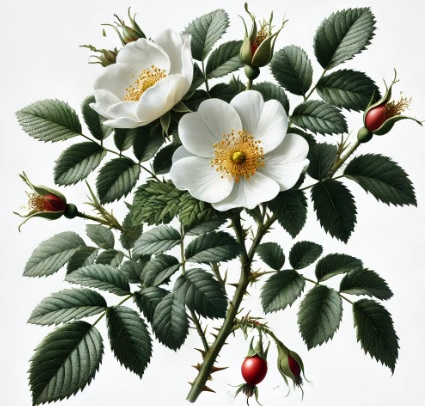Rosa Bracteata is a species of rose belonging to the Rosaceae family, recognized for its ornamental and potential skincare benefits. Commonly known as the "Bracteate Rose" or "Macartney Rose," it is valued for its aesthetic charm and uses in botanical applications.
Botanical Classification:
Scientific Name: Rosa bracteata
Family: Rosaceae
Physical Characteristics:
Appearance: Notable for its large, glossy leaves and bright, fragrant flowers, which are typically yellow or pale pink.
Size: This is a climbing rose that can grow extensively, making it ideal for ground cover or trellises.
Growth Habit: Vigorous and fast-growing, suitable for a variety of landscape designs.
Chemical Composition:
Floral Extracts: Contains natural antioxidants, vitamins, and flavonoids that may offer beneficial effects for the skin.
Leaves and Petals: Includes essential oils, tannins, and organic acids with potential therapeutic properties.
Applications:
Skincare: Incorporated into extracts and formulations for its antioxidant and anti-inflammatory properties, potentially aiding in soothing the skin and enhancing complexion.
Cosmetics: Used in beauty products for its natural fragrance and potential skin benefits.
Botanical Studies: Valuable for research into plant-based compounds and their effects on health and beauty.
Environmental and Safety Considerations:
Environmental Impact: Generally considered sustainable and beneficial for enhancing biodiversity in gardens and landscapes.
Safety: Rosa bracteata is generally safe for use in cosmetic and skincare products. This ingredient is generally regarded as safe for use in cosmetics and personal care products when used as directed. Individuals with allergies to Rosaceae family plants should be cautious.
INCI:
Humectant. Hygroscopic compound used to minimise water loss in the skin and to prevent it from drying out by facilitating faster and greater absorption of water into the stratum corneum of the epidermis. The epidermis is the most superficial of the three layers that make up human skin (epidermis, dermis and hypodermis) and is the layer that maintains hydration in all three layers. In turn, the epidermis is composed of five layers: horny, the most superficial, granular, spinous, shiny, and basal. Humectants have the ability to retain the water they attract from the air in the stratum corneum and have the function of moisturising the skin. They are best used before emollients, which are oil-based.
Skin conditioning agent. It is the mainstay of topical skin treatment as it has the function of restoring, increasing or improving skin tolerance to external factors, including melanocyte tolerance. The most important function of the conditioning agent is to prevent skin dehydration, but the subject is rather complex and involves emollients and humectants that can be added in the formulation.
Synonyms:
CAS:
![]() Rosa Bracteata
Rosa Bracteata 

